Comforting warm salmon rice bowl with salmon chunks, seasoned spinach, carrots, and mushrooms, topped with fresh avocado, a fried egg, and homemade sesame citrus sauce with gochujang chili paste.
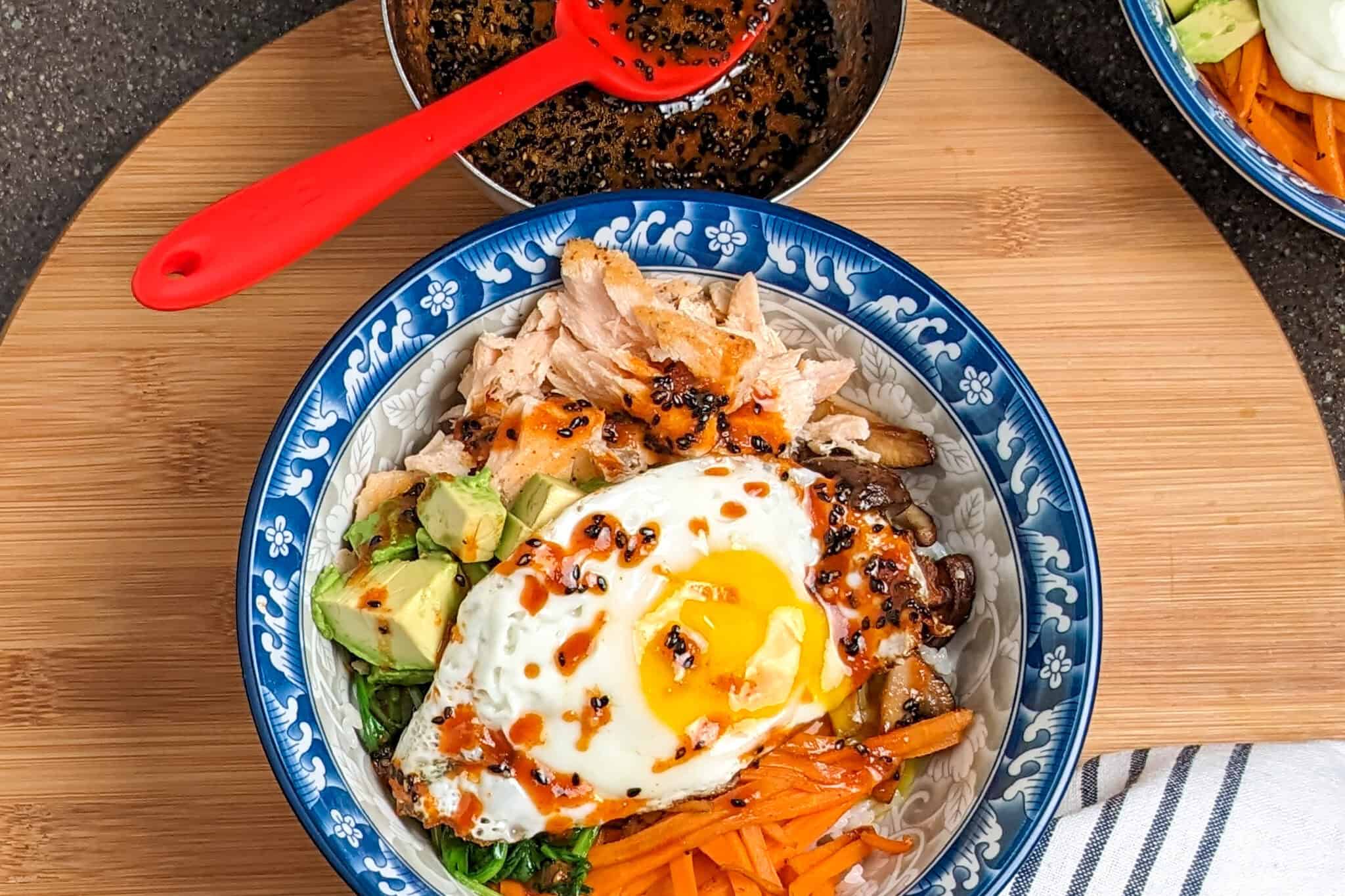
Table of Contents
Jump to:
- Give it up to Korean Cuisine!
- The Korean Influencer
- What’s Bibimbap?
- And Japanese!
- Ingredients with Steps
- Culinary Glossary
- Substitutions
- Variations
- Equipment
- Kitchen Must-Haves Reviews
- Storage
- Cooking Tips
- Frequently Asked Questions
- Fish Recipes
- Asian Recipes
- 📖 Recipe
- Subscribe to my YouTube Channel
- Have a Comment or Question?
Give it up to Korean Cuisine!
Sitting down to a steaming bowl of comforting sticky sushi rice is a delight, especially when accompanied by flaky salmon chunks with freshly seasoned, cooked spinach, carrots, and juicy mushrooms. The fresh avocado chunks with a fried egg are also the perfect creamy touch.
The homemade, banging sesame citrus-flavored gochujang chili paste sauce gave an extra zingy kick to round out the dish! Like many Korean dishes at restaurants and some homes, Bibimbap combines flavors and textures that can be savored when mixing them with your spoon to create one harmonious bite!
For this salmon rice bowl recipe, gochujang sauce, referred to as bibimbap sauce, has a variety of recipes that use ingredients from raw garlic to chili powder. Similarly, this dressing hits several taste profiles: sweet, spicy, salty, and savory.

Looking for authentic Korean recipes? Check out Stella-n-Spice and My Korean Kitchen.
The Korean Influencer
Korean bibimbap has long been an inspiration in my kitchen, and its vibrant medley of flavors and textures led me to create my Sesame Chili Salmon Rice Bowl. While bibimbap traditionally combines a variety of seasoned vegetables, savory gochujang, and a fried egg over warm rice, I wanted to build on those flavors with my own twist.
In this bowl, the foundation remains the same: comforting warm rice, but instead of bulgogi or tofu, I opted for tender chunks of salmon. I kept the seasoned spinach, carrots, and mushrooms—essential to bibimbap's satisfying texture—but added fresh avocado for creaminess.
A fried egg still crowns the bowl, just like in bibimbap, but my homemade sesame citrus sauce, enhanced with gochujang chili paste, brings a zesty, spicy edge that elevates the whole dish. This bowl is a comforting fusion of Korean inspiration with a refreshing twist.
What’s Bibimbap?
As mentioned, this dish was inspired by the comforting iconic dish called bibimbap, Korean for mixed rice. This East Asian dish is traditionally served in a dolsot, a hot stone pot shaped like a bowl. You can hear the crackling of the rice fried with sesame oil in the hot stone pot when it is served.
For a bonus, the dish is usually topped with various sautéed sesame-seasoned crunchy vegetables. It is then topped with thinly sliced meat, usually beef, but it can also be with pork or chicken. Then, it will be served with a fresh raw egg or a fried sunny-side-up egg on top with toasted sesame oil.
The raw egg actually adds creaminess to this satisfying dish. You will also be given kimchi, spicy fermented cabbage, a Korean red chili paste, and a fiery gochujang. On long days, this was my go-to meal when eating out; I would break open my long metal spoon from the paper protector and mix all the ingredients, inhale the toasted goodness, and enjoy!
And Japanese!
The idea for using salmon in this bibimbap inspiration comes from my love for a Japanese-inspired breakfast. I often make broiled miso salmon over sushi rice served with sautéed spinach, fresh avocado, and a poached egg. Knowing how much I love this combination, I knew turning this dish into a Korean-style bibimbap would be just as great.
More Delicious Meal Ideas
- Sweet and Spicy Seafood Neoguri with Mushrooms, Spinach, and Fried Egg
- Easy Sheet Pan Spicy Miso Salmon Rice Bowl
- Air Fryer Spicy Cilantro Lime Salmon Salad Rice Bowl
- Beef Flavored Seaweed Ramyun with Egg, Gochujang, and
- Spicy Tuna Rice Bowl
Ingredients with Steps
Begin by making the sauce: whisk together gochujang, brown sugar, soy sauce, ginger, garlic, sesame oil, lemon juice, rice vinegar, and sesame seeds. Next, sear the seasoned salmon fillets in a hot pan with avocado oil, then set aside. In the same pan, sauté the carrots, spinach, and mushrooms separately, seasoning each with salt, and place them with the salmon.
Fry the eggs until golden brown, then shred the salmon. To assemble the bowl, spread cooked sushi rice evenly, arrange the salmon, sautéed vegetables, and avocado chunks, and top with the fried egg. Drizzle with the sesame chili sauce and serve extra on the side.
Culinary Glossary
This section provides concise definitions of key ingredients and techniques to enhance understanding and improve cooking skills related to this recipe.
- Gochujang - A Korean fermented chili paste made from red chili powder, glutinous rice, and soybeans. It adds a complex, spicy, and slightly sweet flavor to dishes.
- Low-Sodium Soy Sauce - This salty, savory liquid condiment is made from fermented soybeans, wheat, salt, and water. It enhances umami flavors in dishes.
- Toasted Sesame Oil -A richly flavored oil made from toasted sesame seeds, often used in Asian cuisine. It imparts a nutty aroma and flavor to sauces and stir-fries.
- Rice Vinegar - This is a mild vinegar made from fermented rice, commonly used in Asian dishes for its slightly sweet, tangy flavor. You can use any delicate white vinegar (like white wine, sherry, or apple cider).
- Avocado Oil - A high-smoke-point oil extracted from the pulp of avocados. It is ideal for frying and searing due to its ability to withstand high heat.
- Pat Dry - The process of removing excess moisture from ingredients (like fish or meat) using a paper towel before cooking. This helps achieve better browning and crispiness. and allowing seasoning to adhere.
- Sushi Rice - A short-grain, sticky rice typically used in Japanese cuisine. It is seasoned with a mixture of rice vinegar, sugar, and salt for an authentic flavor. You can also use medium-grain white rice.
For quantities, see the salmon rice bowl recipe card.
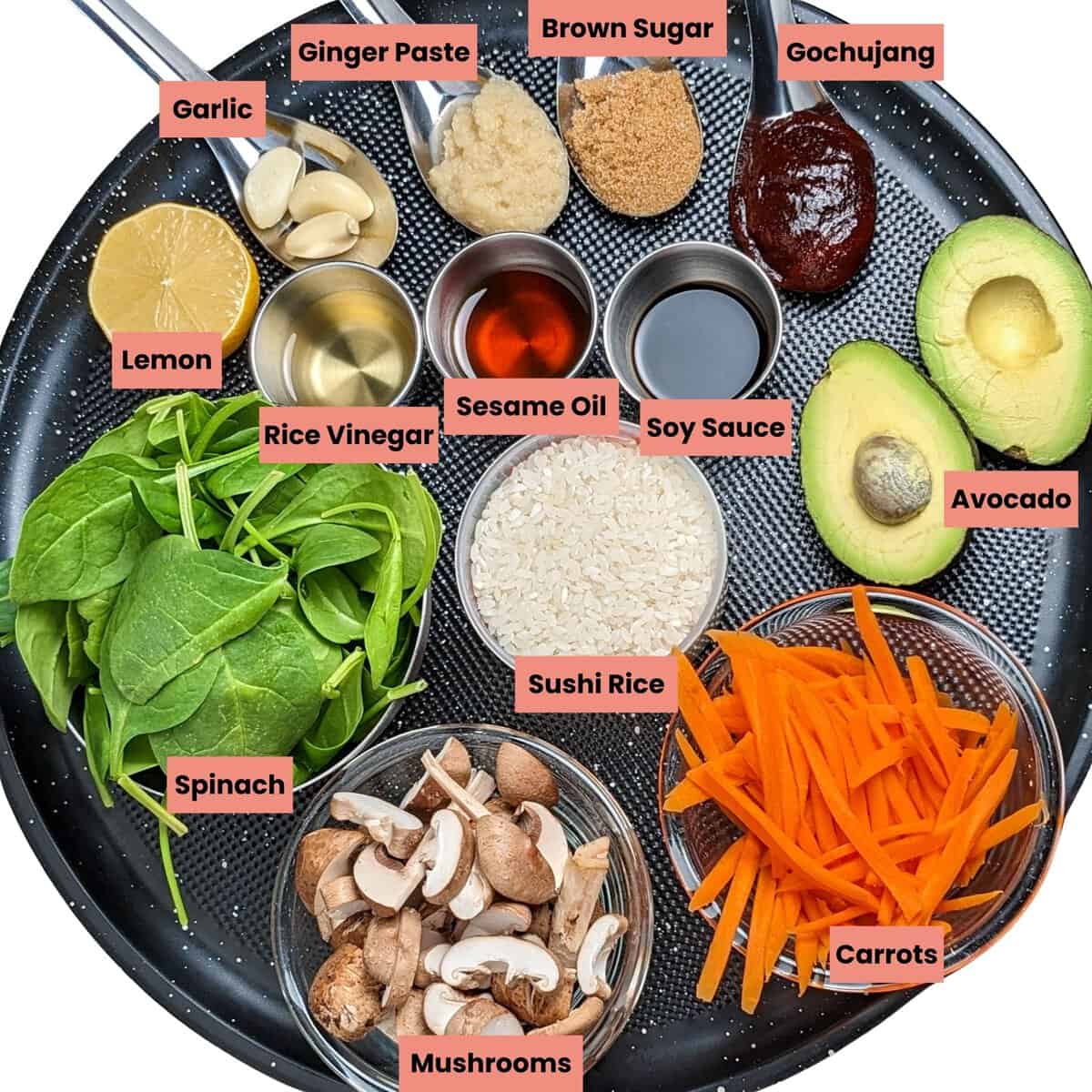
Substitutions
Dairy Free
- Yay! This dish is already dairy-free.
Gluten-Free
- Bonus! This dish is also gluten-free.
Vegetarian
- Salmon Filet - Replace with tofu or tempeh, seasoned and seared like the salmon. Or use canned chickpeas for a quick plant-based protein with dried, crunched-up seaweed.

Want to try a vegan Salmon recipe? Check out Loving it Vegan or It Doesn't Taste Like Chicken.
Convenience
- Gochujang - Substitute with sriracha. It won't be exactly the same since gochujang uses gochugaru, Korean chili peppers made from taeyangcho, which has a specific taste.
- Fresh Spinach - Use frozen spinach, thawed and drained, or substitute with any greens like kale or Swiss chard.
- Carrots and Mushrooms - Substitute toppings with whatever veggies are on hand, such as bell peppers, zucchini, or frozen mixed vegetables.
- Cremini Mushrooms - Use shredded oyster mushrooms or sliced fresh shitake mushrooms.
Change Heat Level - Modify the salmon rice bowl recipe's heat level to your liking and learn more about the Scoville Scale and Chili Pairings.
Variations
- Mushroom Bowl - Omit the salmon and make it with a mixture of your favorite mushrooms!
- Other Vegetables - Add cucumber, shredded cabbage, bean sprouts, or zucchini slices.
Equipment
- Mixing Bowl - Used for making the bibimbap sauce.
- Cast Iron Skillet - To perfectly sear the salmon on high heat and sauté the vegetables. The cast iron pan is excellent for searing fish because it can spread heat evenly, creating a beautiful golden brown crust. However, a medium frying pan will do if you do not have a cast-iron pan.
- Fish Spatula - Used for carefully lifting and flipping the salmon, like the OXO Stainless Steel Fish Turner.
- Mandoline - To slice and julienne the vegetables. However, you can cut it by hand if you do not have a mandoline. In addition to developing this recipe, I used my Benriner Japanese Classic Slicer; it helps to shorten the prepping time.
- Holding Dish - To hold the salmon and vegetables during the cooking process.
Kitchen Must-Haves - Find other tools I use here.
Kitchen Must-Haves Reviews
Find a collection of my reviews of kitchen equipment that I have purchased or recommend.
My Rating: ⭐⭐⭐⭐⭐
My Review: I’ve had my Benriner Mandoline Slicer for over 20 years, and it’s still one of the most reliable tools in my kitchen. While I own the older model, the new version is nearly identical—featuring the same chef-trusted quality, sharp Japanese stainless steel blades, and simple, effective design. It’s been a huge help with meal prep, especially when I need consistent, thin slices fast. Benriner has always been the original go-to mandoline in professional kitchens, and for good reason—it just works. If you want to learn more about how to safely and efficiently use a Japanese mandoline, check out my full guide on the Japanese Mandoline here.
My Rating: ⭐⭐⭐⭐
Purchased: December 10, 2023
My Review: I love the clean, classic look of this Pyrex 3-piece glass mixing bowl set—it’s a staple in my kitchen. Pyrex is known for its durability, and these bowls definitely live up to that reputation. I use them for everything from mixing batters to storing leftovers, and the fact that they’re microwave-safe makes them super multifunctional. They’re also easy to clean and stack nicely in the cabinet. The only reason this isn’t a five-star for me is because I always have that little fear of breaking them when I’m using or storing them, even though they’re made to last.
Storage
- Refrigerator - To store in the fridge, you can combine the rice with the salmon and vegetables in a 2-inch shallow pan to cool down quickly. Then, store in an air-tight sealing container. The rice, salmon, and vegetable mix will last up to three days.
- Freezer - Follow the refrigeration process mentioned above. Then, you can place it in the freezer in a labeled, airtight container.
Airtight Food Containers
I interchange glass food storage containers with plastic clipping lids or wooden push-ins. I always suggest glass storage containers because they can be microwaved, they hold food without staining, and the glass keeps the food at a more stable temperature, keeping it fresher and longer.
Try the OXO Good Grips Smart Seal Glass Rectangle Food Storage Containers or the Pyrex Freshlock Glass Food Storage Containers.
Cooking Tips
Your Cooking Tips Resource Guide - Become a better home cook with tips to help you cook more efficiently on the Cook's Notebook tab.
- Avocado Oil for Searing - Avocado oil is excellent for searing fish due to its high smoke point. However, if you do not have it, you can use canola oil as an alternative.

Japanese Mandoline: How to Shred Carrots
Shredding carrots and other vegetables with a Japanese plastic mandoline ensures uniform, thin slices that cook evenly, save time, and enhance the presentation with precision cuts. Watch Kitchen Tips: How to Shred Carrots. Using a Japanese mandoline is a convenient way to get a variety of uniform cuts in minutes.
How to Remove the Skin of a Fish?
Follow the instructions below for removing the fish's skin using the step-by-step picture guide. Learn more fish-prepping ideas.

Use a sharp knife to slice off the skin by placing the fillet skin side down. Then, turn the fish so that it is horizontal to you.

Make sure your cutting board is sturdy. Then, place the blade right between the skin and flesh with your hand gently placed on top to prevent the fish from moving. Then, gently go with the flow of the skin to cut the skin off.
My Rating: ⭐⭐⭐⭐⭐
Purchased: 10/17/21
Update: 08/19/24
My Review: This knife is well-made. Super solid and multi-functional. It is made with high-carbon steel, so it will not rust. Slicing meat like fish is easier with the grooves. It doesn’t stick to the knife. The handle has an excellent grip, and it's not heavy. For some background, a Santoku is a versatile Japanese kitchen knife characterized by its straight edge and "sheepsfoot" blade, designed for slicing, dicing, and chopping with precision. Its name means "three virtues," referring to its ability to handle meat, fish, and vegetables efficiently, making it a staple in both professional and home kitchens.
How to Dice an Avocado?
To dice avocados, simply cut them in half, remove the pit, slice the flesh into a grid pattern while still in the skin, then scoop out the diced pieces with a spoon.
- Place the avocado on the cutting board horizontally to you.
- Take the knife and place the blade in the center where the stem used to be
- Insert the blade until you hit the seed, and turn the avocado with your hand until the blade has cut around the seed.
- With both hands, separate the halved avocados.
- Then, place the avocado with the seed (seed side up) on our cutting board, and with the blade, hit the seed; it should enter the seed, allowing you to pull the seed up and out with your knife blade. In addition, please be aware of where your fingers are.
- Discard the seed.
- From this point, you make line incisions into the flesh of the avocado horizontally and vertically.
- Then, use a spoon to scoop out the chunks. Note: Please refer to the video for an overview. Disclaimer: In the video, it is done on my hands, but doing this on a cutting board is safer.
Frequently Asked Questions
This is a Korean red spicy hot pepper paste made with fermented ingredients, which gives it a salty, sweet, and savory kick.
These oils can reach a temperature of 400 degrees Fahrenheit before smoking; learn more about high smoke point oils.
Make sure to pat your fish dry to remove excess water that can cause hot oil to splatter. You can also try using an oil splattering guard.
Fish Recipes
Looking for other Fish recipes like this? Try these:
- 20 Irresistible Fish Recipes
- Calabrian Pepper Salmon with Creamy Lemon Dill Sauce
- Seared Snapper Spicy Creole Sauce and Roasted Vegetables
- Sesame Seed-Crusted Ahi Tuna with Spicy Sesame-Soy Sauce
Asian Recipes
Looking for other Asian-inspired recipes like this? Try these:
- Celebrate AAPI Heritage Month with These Top Asian-Inspired Recipes
- Quick Spicy Potstickers | Chili Momo Tibetan Style
- How to Make Multigrain Rice | Purple Rice Recipe
- Lemongrass Marinated Grilled Chicken Spring Rolls
📖 Recipe
Salmon Sesame Chili Rice Bowl
Ingredients
Sesame Chili Sauce
- 1 tablespoon gochujang
- 1 tablespoon brown sugar
- ½ tablespoon low-sodium soy sauce
- 1 tablespoon ginger paste
- 3 cloves garlic minced or pressed
- 1 tablespoon toasted sesame oil
- 1 tablespoon lemon juice
- 1 tablespoon rice vinegar
- 1 tablespoon sesame seeds
Salmon
- 2 fillets salmon fillets, and skin removed
- salt and pepper to taste
- 2 tablespoon avocado oil
Toppings
- 1 large carrot shredded or julienne
- 2 cups fresh spinach
- 8 cremini mushrooms (aka baby bella) sliced thin
- 1 tablespoon avocado oil
- 2 large eggs
- salt and pepper to taste
- ½ avocado
Serve With
- ½ cup cooked sushi rice
Equipment
Instructions
- Make the Sauce: In a small bowl, whisk together gochujang, brown sugar, soy sauce, ginger, garlic, sesame oil, lemon juice, rice vinegar, and sesame seeds. Set aside.
- Sear the Salmon: Pat the salmon dry, season with salt and pepper. Heat avocado oil in a medium-hot pan and sear the salmon flesh side down. After 2-3 minutes, flip and cook until browned. Remove from the pan and set aside.
- Cook the Veggies: In the same pan, sauté the carrots, spinach, and mushrooms with a pinch of salt, one at a time, for 1-2 minutes each. Set aside with the salmon.
- Fry the Eggs: Add more oil if needed and fry the eggs until golden on the edges. Set aside.
- Assemble the Bowls: Shred the salmon, then divide the cooked rice into bowls. Top with salmon, veggies, and avocado, and place a fried egg in the center.
- Serve: Drizzle the sauce over the bowls and serve extra sauce on the side.
Video
Nutrition
Subscribe to my YouTube Channel
SUBSCRIBE: 👈To my YouTube Channel to Get Notifications of New Videos.
Have a Comment or Question?
If you have a question or comment about this salmon rice bowl recipe, please post it below. You will definitely get a quick response. It also helps our other readers to stay informed. Thanks!

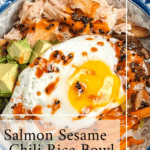

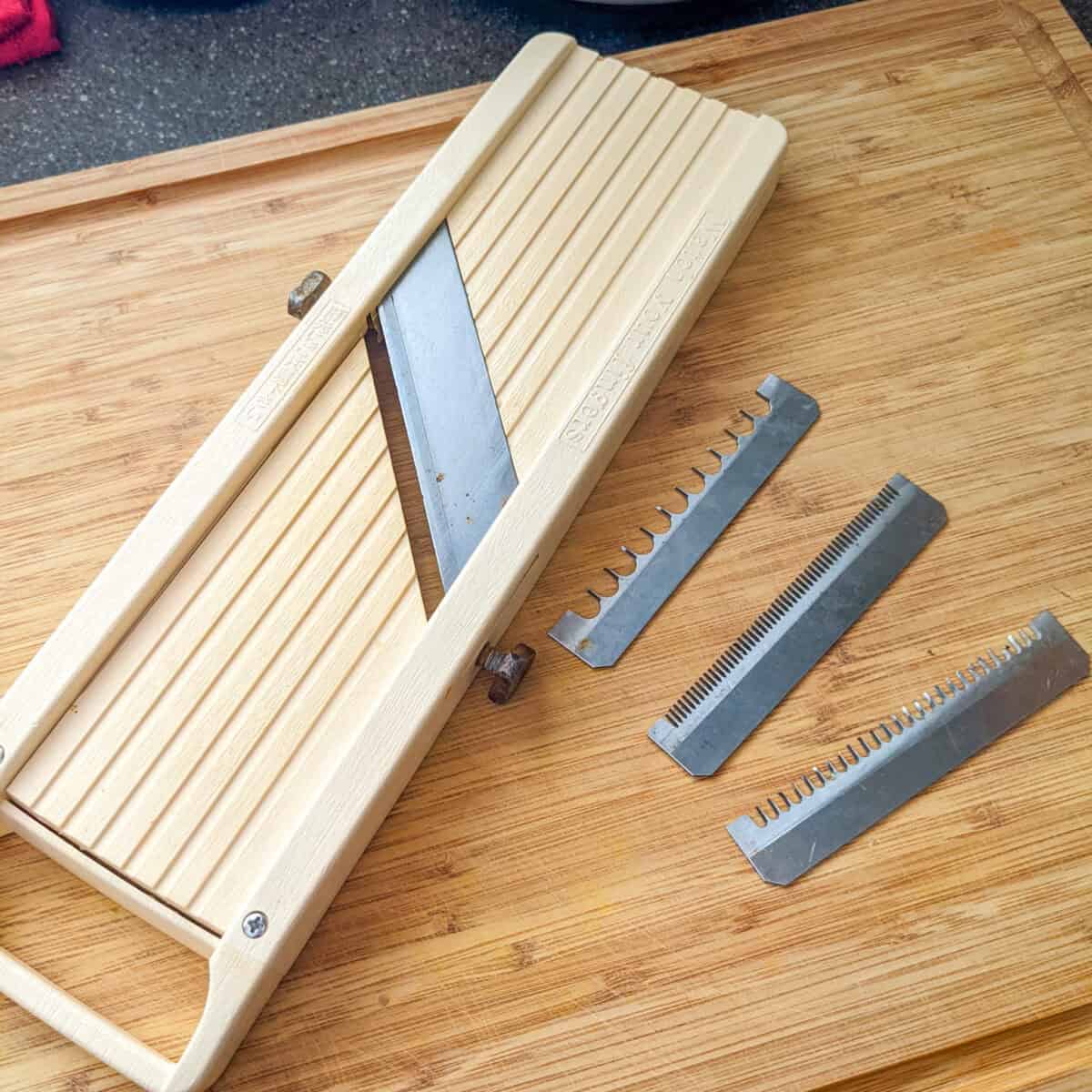
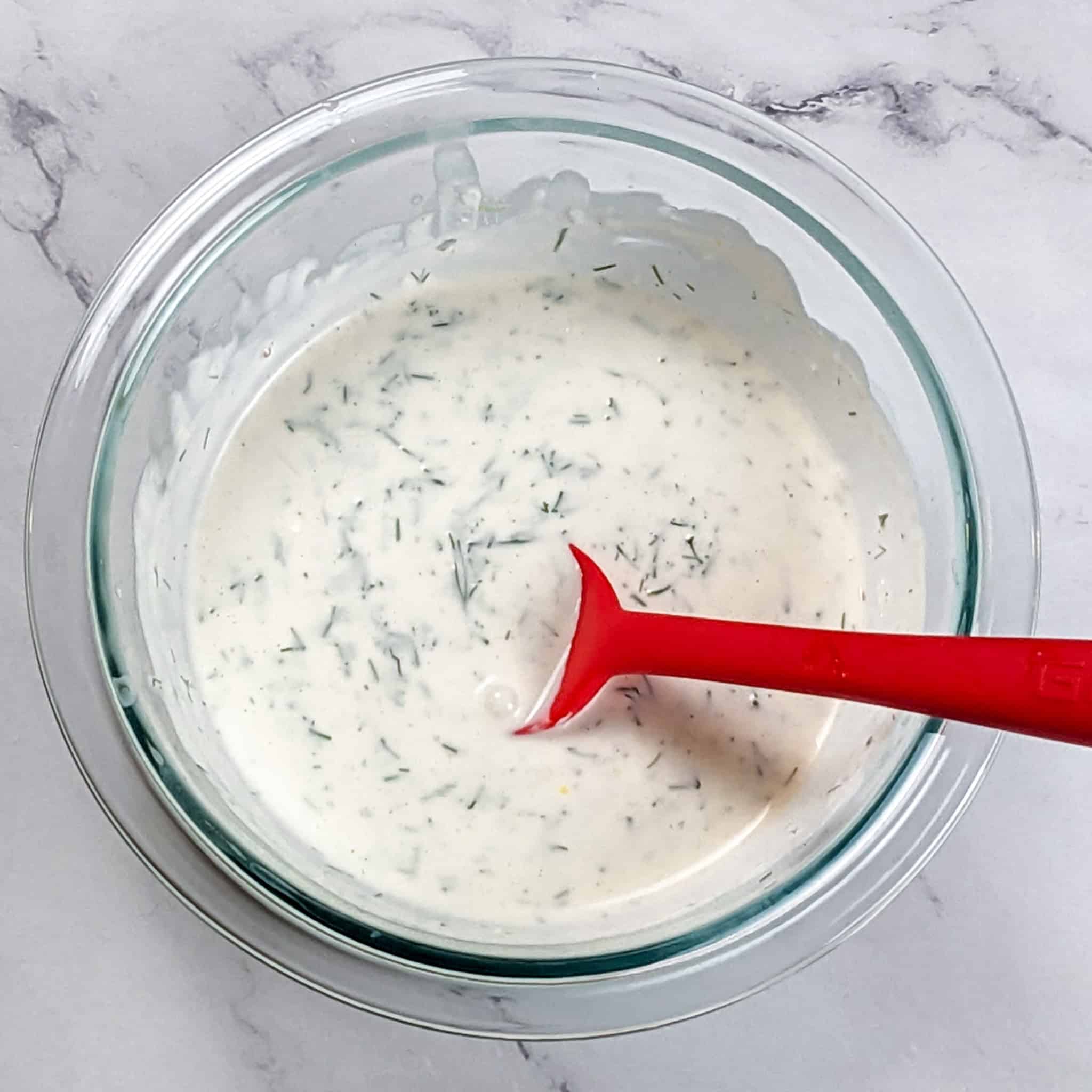
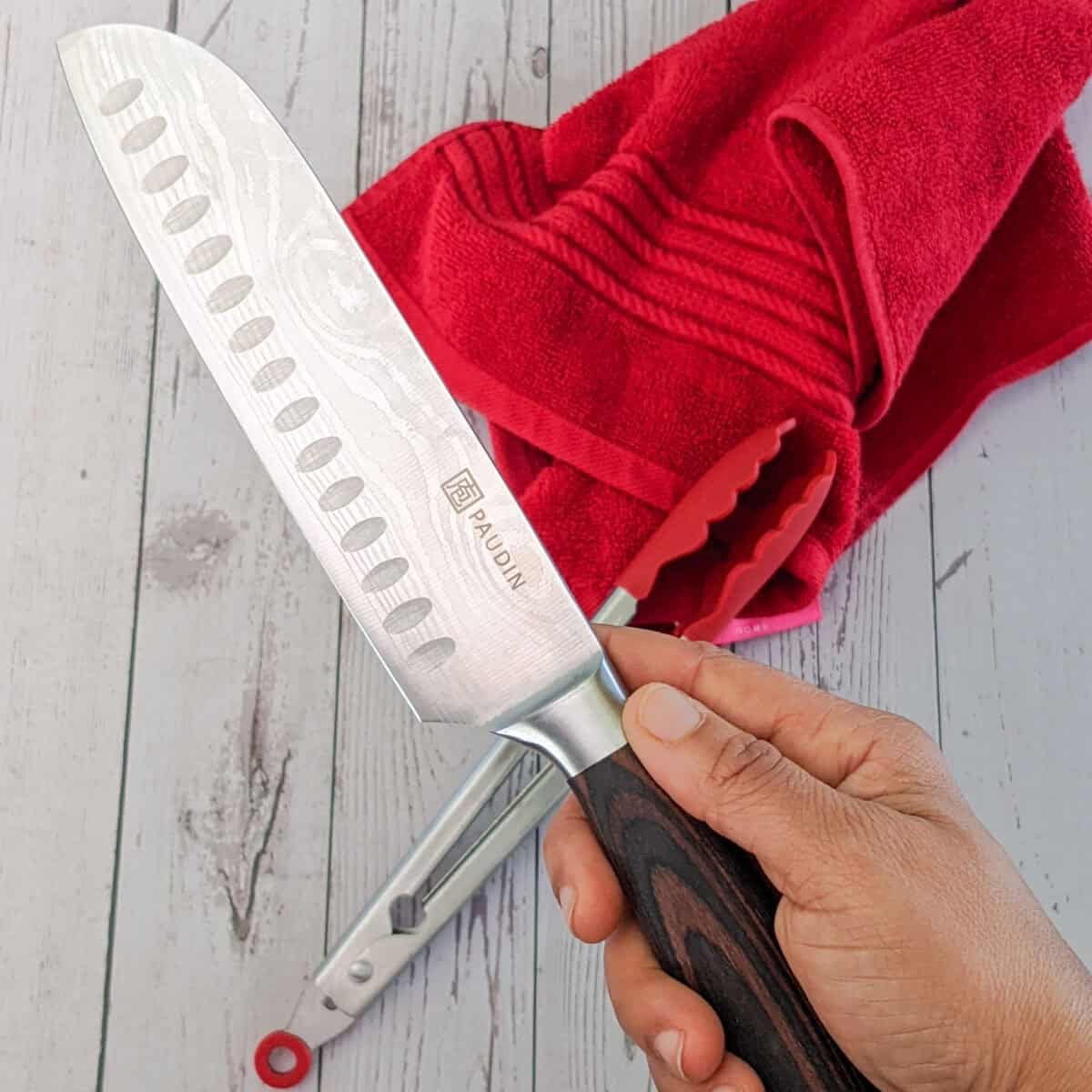
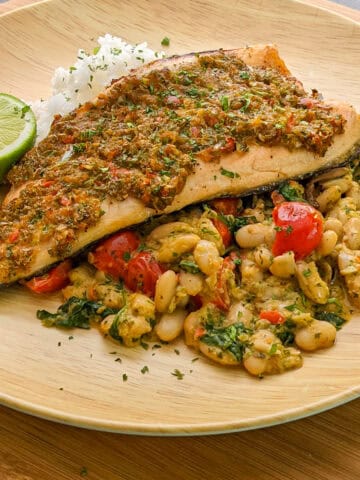
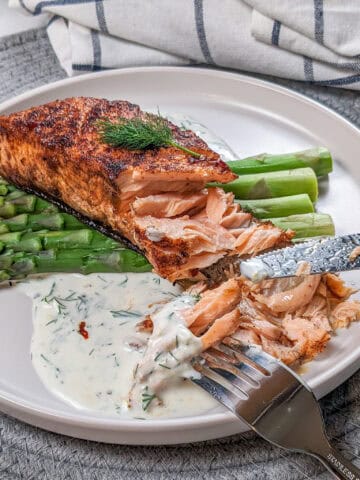
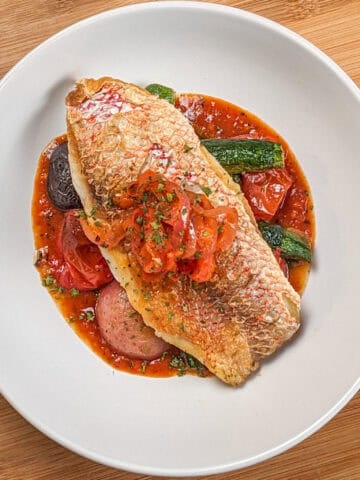
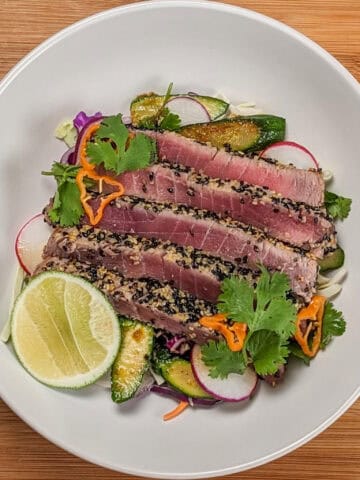
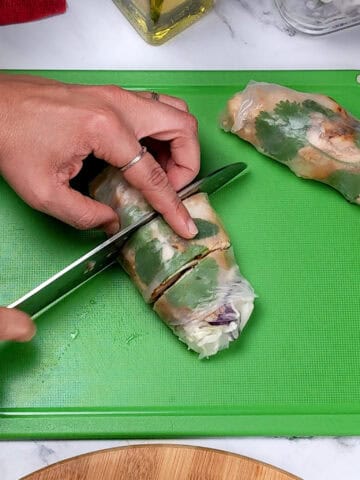
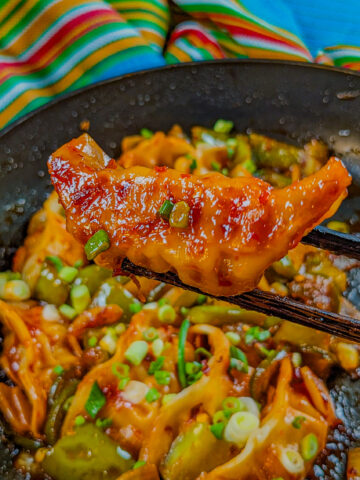
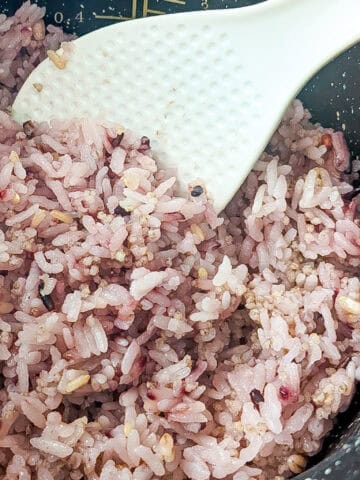
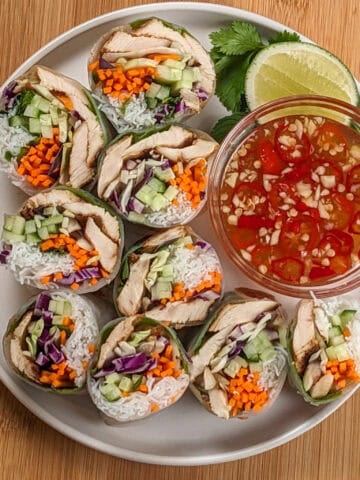
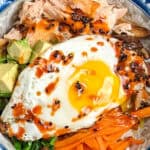
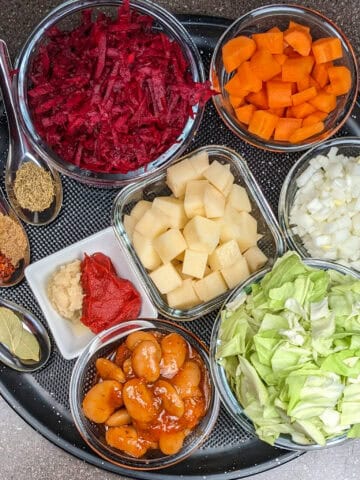
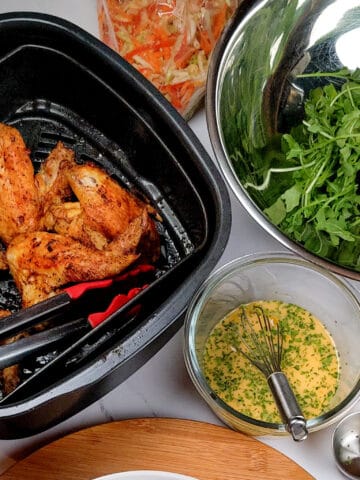
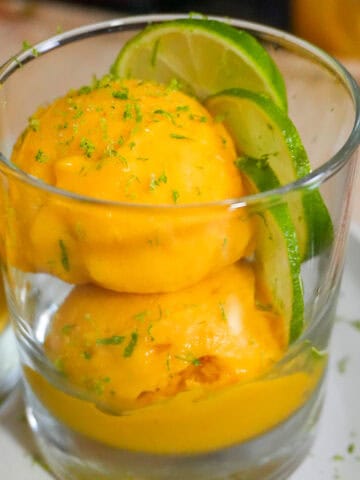
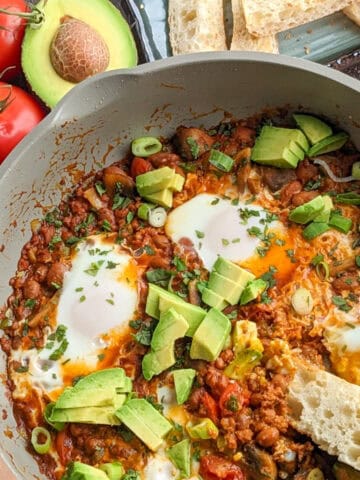
Leave a Reply